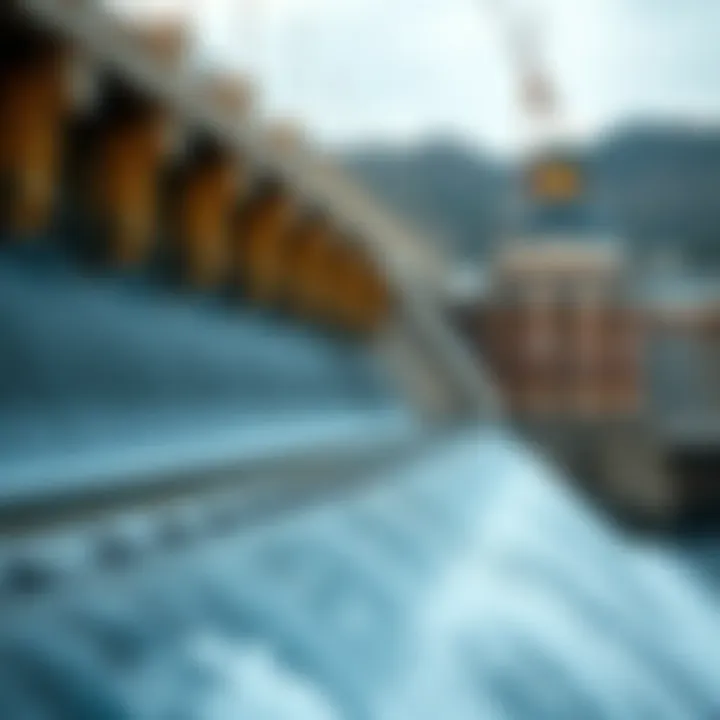Exploring the Architectural Impact of سد حتا


Intro
The سد حتا, or Hatta Dam, is not just a piece of infrastructure in the United Arab Emirates; it stands as a testament to strategic planning in both architecture and environmental stewardship. Nestled in the picturesque Hatta region, this dam has become a pivotal point for discussions surrounding water resource management, ecological balance, and regional development.
Recognizing the historical significance and contemporary implications of سد حتا offers valuable insights into its impact on societal dynamics, as well as how it shapes relationships between the environment and human activity. In what follows, we will unearth the architectural details, sorted through the lens of environmental relevance, which are crucial for stakeholders ranging from engineering gurus to environmental advocates.
By providing a thorough examination of this landmark, we aim to illustrate its role beyond mere water retention, shining a light on the intricate web of ecological interdependencies and economic opportunities it fosters. The importance of سد حتا goes far beyond its initial purpose, acting as a keystone in an evolving landscape that demands both innovation and preservation.
Prolusion to سد حتا
سد حتا, located in the stunning mountainous backdrop of the Hatta region, holds a pivotal place in the architectural and environmental narrative of the United Arab Emirates. This formidable dam not only stands as an example of modern engineering prowess but also showcases the integration of sustainable practices with historical considerations in the realm of water management.
At first glance, سد حتا captivates with its impressive structural design that reflects both functionality and aesthetic appeal. However, diving deeper reveals its multifaceted significance, especially within the context of the UAE's growing infrastructure needs. The importance of سد حتا stretches beyond just its physical presence. It symbolizes a commitment to initiatives that focus on ecological balance and responsible resource utilization in an arid region.
There are specific elements that stakeholders, including investors and developers, should consider when engaging with سد حتا:
- Water Management: The dam is a cornerstone for fostering effective water management strategies. Its reservoirs play a crucial role in supplying fresh water—a precious commodity in arid climates—to local communities and farming endeavors.
- Environmental Sustainability: It is designed to minimize environmental impact while promoting biodiversity in surrounding areas. By maintaining water levels and natural habitats, it contributes positively to the ecological fabric of the region.
- Cultural Relevance: The structure also resonates culturally, bridging modern advancements with historical precedents in UAE’s architecture, thus appealing to both locals and visitors alike.
In consideration of these factors, the future trajectories for سد حتا are ripe with potential. It can be a linchpin for innovative projects targeting efficient water usage, smart city initiatives, and tourism development. As we explore the ensuing sections about its historical context and engineering features, it's essential to recognize how سد حتا is more than just a dam—it is a fundamental component in the quest for sustainability and resilience in the UAE's environment.
"سد حتا is not merely an engineering feat; it is a testament to our resolve for a sustainable future in a challenging landscape."
With an understanding of the foundational role this dam plays, we will now delve into its historical context, analyzing both its early development and its significance within the wider infrastructure framework of the UAE.
Historical Context
The historical backdrop of سد حتا is crucial for understanding its architectural and environmental significance. Over the years, this dam has transformed from just a structure to a linchpin for sustainable growth in the United Arab Emirates. It reflects not only engineering prowess but also serves as a critical response to the region's water scarcity issues.
Early Development
The early developmental phase of سد حتا can be traced back to the late 20th century, when the UAE was beginning to establish its identity and infrastructure. Strategic planning was essential, as the country faced a pressing need for effective water management. The government recognized that diminishing water resources were a disaster waiting to happen.
In 1990, the project was conceptualized, with construction beginning shortly after. Engineers and architects collaborated closely, ensuring that the dam not only met functional demands but also harmonized with the local landscapes. This collaboration advanced the dam into a modern engineering marvel, adept at collecting and storing water from the Hatta region's mountains. The finished construction in 1996 marked a significant turning point in the UAE's ability to manage its invaluable water resources.
Significance in UAE's Infrastructure
The role of سد حتا in the UAE's infrastructure cannot be overstated. As it stands, this dam is more than just a barrier holding back water; it is a robust framework that supports various sectors, including agriculture, tourism, and urban development.
- Firstly, it has remarkably boosted agricultural productivity in the arid regions surrounding Hatta. Water access has allowed local farmers to cultivate crops that were previously impossible to grow here.
- Secondly, سد حتا has made a name for itself in the realms of eco-tourism, drawing visitors for its breathtaking views and recreational opportunities. People often find themselves exploring hiking trails and engaging in water sports, not to mention the educational tours that enable them to learn about the dam's construction and ecological importance.
- Lastly, the dam plays an essential role as a cornerstone of sustainable urban planning in the UAE. By managing water resources efficiently, it mitigates potential crises that could arise from water shortages, ensuring long-term socio-economic stability for the region.
The dam’s contribution to both ecological balance and development is an eloquent reminder that human ingenuity can indeed coexist with nature.
Engineering Features
When examining سد حتا, its engineering features stand out as critical elements that contribute significantly to its overall function and impact. The dam's engineering prowess not only highlights human ingenuity but also reflects the practical needs of the region, which faces unique challenges regarding water management in a predominantly arid landscape. Understanding these engineering feats helps illuminate the dam's crucial role within the environmental and socio-economic fabric of the UAE.
Design Specifications
The design of سد حتا is crafted with precision, addressing both the technical and environmental demands of the region. At its core, the dam is designed to hold back substantial volumes of water, facilitating irrigation, recreational activities, and flood control.
- Height and Structure: Standing tall at approximately 60 meters, سد حتا features a rock-fill dam structure. This design ensures stability under pressure while encouraging the natural absorption of water into the surrounding geology, minimizing evaporation losses.
- Water Storage Capacity: The dam has the capacity to hold around 100 million cubic meters of water. It’s calibrated to cater to peak demand periods, ensuring that the water supply meets the needs of both agricultural and urban areas.
- Spillway Features: One of the standout design elements is its controlled spillway system, which regulates water release during heavy rainfall. The strategic positioning of these spillways prevents excessive erosion and monitors the environmental flow into downstream ecosystems.
Highlighting these specifications not only emphasizes innovative civil engineering but also demonstrates a thoughtful approach towards environmental stewardship.
Construction Techniques


The construction of سد حتا employed a mix of traditional methods and modern technological enhancements, showcasing a balance between innovation and practicality. This approach has facilitated the dam's robust design and ensured its longevity in a challenging environment.
- Material Sourcing: The primary materials used in the dam's construction were sourced locally, underscoring sustainable practices. Rock and aggregate were carefully selected to maintain compatibility with the region's geological conditions.
- Techniques Applied: Engineers utilized advanced compaction techniques to ensure that each layer of rock and fill was densely packed. This not only provided structural integrity but minimized settlement over time, a common issue in dam construction.
- Monitoring and Testing: Throughout the build, real-time monitoring systems were employed. These systems assessed the structural behavior of the dam and contributed to adjustments during the construction phase, enhancing safety and reliability.
Together, these construction techniques reflect an astute understanding of the demands posed by both engineering constraints and environmental considerations. The marriage of modern techniques with nature's imprints creates a dam that not only serves its purpose efficiently but respects the territory it inhabits.
Environmental Impact
The environmental significance of سد حتا cannot be overstated. This dam plays a dual role, not only in harnessing water but also in shaping the ecological landscape of the region. It serves as a pivotal element in ensuring a stable ecosystem, providing habitats for various flora and fauna while contributing to the overall environmental health of the area. This section delves deeper into two critical aspects: Ecological Balance and Water Resource Management.
Ecological Balance
سد حتا has successfully contributed to maintaining ecological balance in a region often prone to water scarcity. The dam acts as a artificial reservoir, regulating water flow and mitigating the risks of flooding and drought. This careful management of water resources helps preserve the natural habitats surrounding the dam. Species that rely on consistent water availability, whether local fish or unique vegetation, find sustenance in the nuanced environment cultivated around سد حتا.
Moreover, the vegetation surrounding the dam is strategic. Native plant species have been prioritized to maintain the integrity of the local ecosystems. These plants, unlike invasive species, provide excellent cover for small animals and insects, fostering biodiversity.
- Preservation of Habitats:
- Native plants provide habitats.
- Supports local wildlife and insects.
The introduction of wildlife corridors has further allowed for movement, ensuring that creatures can migrate without obstruction. Such measures reinforce the resilience of the ecosystem, enabling it to withstand various environmental pressures. It’s not just about managing water; it's about cultivating a symbiotic relationship with nature, something that needs careful attention yet rewards the area multifold.
"Ecosystems are built on balance, and سد حتا is a fine example of how human ingenuity can align with nature's needs."
Water Resource Management
Water management is a core benefit brought forth by سد حتا. The design of this dam ensures that water resource management goes beyond mere storage. It transforms the way water is utilized and conserved, serving both urban and agricultural needs across the UAE.
The gravity-fed water distribution system allows local irrigation projects to flourish, thus boosting agricultural productivity. Through a series of gates and channels, farmers have reliable access to water, which is an invaluable resource in a desert ecosystem. This careful planning not only conserves water but also reduces wastage, optimally utilizing each drop.
- Benefits of Water Resource Management:
- Improved agricultural yield.
- Reduction in water wastage.
- Meeting urban demands efficiently.
In addition, سد حتا's reservoirs serve as a buffer during times of fluctuating demand, allowing for a consistent supply despite seasonal changes. This versatility showcases the dam's importance in long-term strategies for sustainable water management.
By intertwining ecological balance with effective water resource management, سد حتا emerges as more than a mere structure, but as a vital lifeline that sustains both nature and human activity in this vibrant region.
Socio-Economic Contributions
The dam سد حتا serves more than just a function for water management; it brings substantial socio-economic benefits to the local and broader communities. Its significance stretches across various dimensions, from enhancing local livelihoods to bolstering tourism and recreational activities, making it an indispensable asset in the United Arab Emirates. The benefits derived here resonate deeply with various stakeholders, including investors, agents, developers, buyers, and managers.
Impact on Local Communities
The effects of سد حتا on local communities are palpable. Improved water availability for agriculture has allowed local farmers to diversify their crops, increasing not only production but the quality of life in these areas. This has given rise to increased employment opportunities, creating jobs that cater to farming, maintenance, and service sectors surrounding the dam.
Furthermore, there’s an enhanced sense of community engagement. Residents often participate in local initiatives aimed at preserving the dam’s ecosystem while simultaneously benefitting from its resources. This not only nurtures local cultures but strengthens social bonds amongst community members, providing a shared purpose.
Role in Tourism
Adventure Activities
The adventure activities centered around سد حتا have a strong draw, serving as a magnet for thrill-seekers and outdoor enthusiasts. Mountain biking, hiking, and kayaking are just a few of the exhilarating options available. The picturesque backdrop of the dam enhances the experience, offering both beauty and challenge.
These activities are particularly appealing as they cater to varied skill levels and interests. For instance, the mountain biking trails provide not just an adrenaline rush but also the chance to appreciate stunning views of the Hatta region. This reliability as a tourist hotspot helps stimulate local economies, as businesses and vendors thrive due to increased footfall.


Educational Tours
Educational tours offered at سد حتا present an important aspect of the dam's contributions to society. Such tours aim to enlighten visitors about water management, sustainability practices, and the dam’s environmental significance. This information is crucial, especially in a water-scarce region like the UAE.
Schools and universities often take advantage of these tours, providing students firsthand knowledge that cannot be gleaned from textbooks. This direct engagement fosters a deeper understanding of environmental sciences, particularly among the youth. The tours also encourage stewartship towards natural resources, planting seeds of awareness for future generations.
Overall, the socio-economic contributions of سد حتا significantly affect the local communities, offering pathways for economic growth and educational enrichment. It stands as a testament to what a well-planned structure can achieve beyond its primary function.
Future Developments
Future developments concerning سد حتا carry significant merit for a variety of stakeholders involved in its management and the surrounding ecosystem. As the region grapples with the dual pressures of increasing population and climate change, the enhancement of this infrastructure plays a critical role in sustaining both environmental and economic health. Keeping this context in mind, we can observe several facets of anticipated progress that will contribute to the evolution of سد حتا, making it a pivotal component of the UAE’s water management strategy.
Planned Expansions
Planned expansions at سد حتا are not merely infrastructural projects; they symbolize a commitment to adapting and evolving. Enhancements may include increasing the dam's capacity to store water, which is crucial given the heightened risk of water scarcity.
- Capacity Upgrades: Current proposals suggest raising the dam's height incrementally, thereby enabling it to hold additional water during heavy rainfall periods. This adjustment addresses concerns related to both droughts and flash floods, ensuring a more stable water supply throughout the year.
- Infrastructure Improvements: New channels and spillways will be proposed to better manage overflow during storm events, minimizing potential damage to surrounding areas and improving overall flood management efficiency.
- Recreational Developments: There is also talk of integrating recreational amenities. This blend of utility and leisure can not only bolster local tourism but also serve as a community focal point, fostering greater public appreciation of the dam's ecological significance.
The importance of planned expansions goes beyond just increasing capacity. Such developments foster collaboration between engineers, environmental scientists, and local governments, ensuring a multidisciplinary approach that aligns with both ecological and social needs.
Innovations in Water Management
As we delve into innovations in water management, the future of سد حتا looks bright with the prospect of adopting new technologies and strategies. These innovations are focused on optimizing the use and conservation of water resources, which is paramount in a desert climate.
- Smart Water Monitoring Systems: Future advancements may include sensor technologies that provide real-time data on water quality and levels. By implementing IoT technologies, the management of water resources will transform from reactive to proactive, allowing for timely interventions when necessary.
- Sustainable Water Practices: Emphasizing recycling and treatment processes for wastewater can significantly contribute to water resource management. Investment in systems that allow for the repurposing of treated water for irrigation or industrial use contributes to a circular economy, decreasing reliance on natural water sources.
- Community-Based Monitoring Programs: Engaging the local populace in monitoring programs not only raises awareness about conservation but also fosters responsibility within communities. Participatory governance in water management encourages sustainable practices and ensures local needs are met effectively.
"Innovations in technology and community involvement can create a resilient framework for water management, crucial for سد حتا's future success."
As سد حتا embarks on these new paths, it stands as a beacon of forward-thinking, balancing the urgent need for water resources with a sustainable framework that respects the environment and engages the community.
Challenges and Solutions
The topic of challenges and solutions regarding سد حتا underscores the necessity to understand both the obstacles faced by the dam and the responses enacted to mitigate these concerns. As the complexity of environmental issues grows, it becomes essential to delve into the nuanced interplay between engineering and ecology. As such, recognizing these challenges is paramount, especially for stakeholders involved in planning and resource management.
Environmental Concerns
One integral challenge revolves around environmental concerns associated with سد حتا. While the dam plays a critical role in water management, its presence can disrupt natural habitats and species. Notably, aquifers that feed into the rivers and streams may experience changes in water quality and quantity. This dramatical shift can alter the aquatic ecosystem that local wildlife depends on. It's like trying to stir a pot of soup that has too many ingredients; the flavor becomes unbalanced.
- Habitat Disruption: Construction and operation phases can lead to disruption of local flora and fauna. Species may be forced to adapt or relocate, affecting biodiversity in the region.
- Water Quality: Chemicals and pollutants from construction activities can seep into nearby water bodies, raising concerns among environmentalists and community activists.
- Erosion and Sedimentation: The dam alters river flows, potentially increasing erosion upstream and affecting sediment patterns downstream. This can cause silting in critical aquatic spaces.
Despite such concerns, awareness of these issues has driven positive changes. Efforts from local authorities have brought about strategies aimed at monitoring and minimizing the impact. For instance, regular water quality assessments ensure transparency in handling pollutants.
Sustainability Measures
In light of the environmental challenges faced, it is crucial to explore sustainability measures that can be applied to سد حتا. These measures function as proactive steps aimed at enhancing ecological balance while maintaining the dam's functionality. The intention is not just to tackle existing problems but also to prevent new ones from cropping up.
- Reforestation Projects: Initiatives to plant trees around the dam limit soil erosion while supporting local species. A green cover absorbs excess rainwater, thus protecting water quality.
- Eco-Friendly Construction Materials: The use of sustainable building materials in ongoing and future projects can lessen the ecological footprint. By opting for such resources, the integrity of local surroundings is better preserved.
- Community Involvement: Engaging local communities in conservation efforts can lead to a stronger sense of ownership over local resources. Workshops or educational programs can foster awareness about sustainable practices.
- Biodiversity Monitoring: Implementing systems for tracking wildlife populations and their health can pave the way for adaptive management strategies. This information can inform decision-makers on necessary adjustments to operations or maintenance.
"Sustainability is not just a buzzword; it’s a necessity for the future of our shared environment."
As these sustainability strategies unfold, the relationship between سد حتا and the ecosystem can evolve into a more harmonious coexistence. By carefully balancing the needs of human development with the preservation of environmental health, stakeholders can ensure the longevity of both the dam and the ecological areas it impacts.
Legal and Regulatory Framework
Understanding the legal and regulatory framework surrounding سد حتا is key to appreciating its architectural and environmental significance. This framework establishes the policies and regulations that guide the dam's construction, operation, and maintenance. Such regulations not only ensure the structure adheres to safety standards but also facilitate sustainable environmental practices.


Government Policies
Government policies play a pivotal role in the establishment and operation of سد حتا. They provide a roadmap for how resources are managed, aligning with national goals for sustainable development. In the UAE, the government has prioritized infrastructure projects that include dams and water resource management to address the challenges posed by arid conditions.
The relevant policies generally focus on several aspects:
- Water Resource Management: Governments outline how water is allocated, used, and preserved.
- Sustainability Initiatives: Policies may encourage eco-friendly practices in construction and water usage, highlighting the importance of preserving local ecosystems.
- Safety Standards: Regulations assure that construction and operations comply with safety guidelines to mitigate risks, particularly during operational phases such as flood management.
Official bodies, like the Ministry of Energy and Infrastructure, have set frameworks that govern these practices, ensuring that سد حتا remains compliant with national and international laws.
International Standards
Compliance with international standards reinforces the credibility and safety of سد حتا’s operations. Adopting globally recognized frameworks ensures the dam is built and operated following best practices. These standards often influence construction methodologies, environmental assessments, and operational guidelines.
Key aspects of international standards may include:
- Environmental Impact Assessments (EIA): Conducting thorough assessments ensures that projects like سد حتا adhere to environmental protection standards before embarking on construction.
- Quality Control in Construction: International building codes encourage the use of high-quality materials and advanced engineering techniques, enhancing the dam's longevity and resilience.
- Crisis Management Protocols: In the face of potential natural disasters, these standards lay out comprehensive emergency response plans that safeguard both the structure and nearby communities.
In essence, the legal and regulatory framework surrounding سد حتا is not just a bureaucratic necessity; it is a crucial component that safeguards the interests of both the environment and the communities that rely on this impressive feat of engineering.
Community Engagement
Community engagement around سد حتا plays a pivotal role in intertwining the dam’s significance with the lives of the people who surround it. Understanding and involving local communities in discussions about environmental and architectural projects fosters a sense of ownership and responsibility. Engaging communities leads to benefits that extend beyond mere cooperation; it weaves the fabric of society itself.
The potential advantages of active community engagement are vast. Stakeholders gain insights that reflect the community’s needs and preferences, which can inform future projects and developments. When citizens feel heard, they are more likely to advocate for sustainable practices and conservation efforts. Moreover, the results of effective engagement strategies can align community development with national goals.
A few considerations highlight why community engagement is essential in the context of سد حتا:
- Empowerment: Involving locals ensures they are part of the decision-making process, empowering them to be proactive in environmental stewardship.
- Transparency: Open communication fosters trust between the dam management and the local populace, which can reduce resistance to future developments.
- Cultural Connection: Engaging with the community helps preserve local heritage and encourages contributions that reflect cultural significance.
"Community engagement is not merely a box to check, but a foundation upon which successful projects can be built."
Public Awareness Campaigns
Public awareness campaigns surrounding سد حتا are an integral part of ensuring that the community comprehends both the ecological and infrastructural importance of the dam. These campaigns help demystify the dam’s operations, illustrating how they directly affect everyday life. Such initiatives are crucial for educating the populace about the role of سد حتا in local water management and disaster prevention, fostering both appreciation and participation.
Key elements that make these campaigns effective include:
- Tailored Messaging: Clear messages that resonate with local concerns ensure that the community can relate their experiences to the dam’s purpose.
- Interactive Learning: Organizing workshops and seminars creates an engaging platform for knowledge sharing, making the information accessible and digestible for all ages.
- Media Outreach: Utilizing social media and local news outlets to spread awareness can amplify reach. Informative posts, blog articles, and videos can enlighten a larger audience.
Collaborative Projects
Collaborative projects have proven to be an effective means of involving the community in the oversight and enhancement of سد حتا. These initiatives bring together local government, NGOs, and residents, thereby uniting various stakeholders under a common goal. Collaborative efforts can take many forms, from biodiversity projects around the dam’s perimeter to educational programs that promote water conservation.
Benefits of such collaborations are noteworthy:
- Shared Resources: Pooling resources among various groups increases the project’s effectiveness, whether it be through shared funding, expertise, or manpower.
- Innovative Solutions: Diverse perspectives often lead to creative problem-solving approaches that benefit all partners involved.
- Sustainable Development: These projects illuminate the path toward sustainable community development, ensuring that local needs and environmental considerations coexist harmoniously.
In summary, robust community engagement surrounds سد حتا on multiple levels, from public awareness campaigns to collaborative projects. This engagement serves not only to enhance local identity but also to promote long-lasting environmental stewardship, ensuring that both the dam and its surroundings flourish for generations to come.
Closure
The conclusion serves as a crucial chapter in understanding the overall significance of سد حتا. Throughout the article, various aspects of this dam, from its historical grounding to its implications on local ecology and economy, have been explored. The multifaceted nature of سد حتا highlights its vital role in shaping not only the physical landscape of the United Arab Emirates but also the socio-economic fabric of the surrounding communities.
Key Takeaways from the Article:
- Infrastructure and Growth: سد حتا is a linchpin in the UAE’s infrastructure, significantly contributing to water management strategies, which in turn support agricultural and urban development. Its design reflects a sophisticated understanding of both engineering principles and environmental necessities.
- Environmental Stewardship: The ecological impacts addressed throughout the article emphasize how سد حتا balances human needs with environmental preservation. Striking this balance is increasingly vital as the UAE navigates climate change and a growing population.
- Community Involvement: A noteworthy element is the emphasis on community engagement and public awareness around سد حتا. The active involvement of local populations in decision-making processes not only fosters goodwill but also ensures that the benefits of the dam are felt broadly rather than concentrated in specific sectors.
The consideration of both current and future developments at سد حتا suggests a commitment to ongoing improvement and adaptation, which can serve as a model for similar infrastructural projects globally.
As this article presents, سد حتا is much more than a dam; it is an emblem of a forward-thinking approach to environmental management practices, socio-economic development, and regional stability. Stakeholders from varied sectors—be they investors, developers, or local communities—are encouraged to consider the lessons learned from سد حتا as they plan for future initiatives.
In sum, the importance of سد حتا extends beyond its functional capabilities, offering insights into sustainable growth, community action, and strategic planning necessary for complex infrastructural endeavors. The architectural and environmental narrative woven around the dam showcases a proactive response to both existing challenges and future aspirations.







